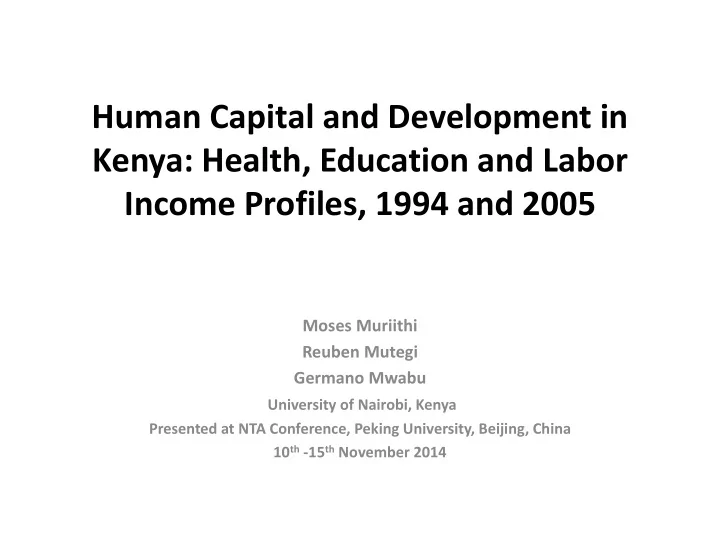

Human Capital and Development in Kenya: Health, Education and Labor Income Profiles, 1994 and 2005 Moses Muriithi Reuben Mutegi Germano Mwabu University of Nairobi, Kenya Presented at NTA Conference, Peking University, Beijing, China 10 th ‐ 15 th November 2014
Introduction • Long Term National Plan for Kenya, KENYA _VISION_2030, recognizes the role of human capital in development • Health and education are identified as vital ends in themselves and as means of national development
But Plan lacks information on... • Expenditure on health and education services by age and gender • Productivity of human capital or its return, by age and gender • Human capital created within households or in household enterprises, especially by women
This information is needed To design policies that would promote : • Human capital formation (health and education) by age • Social protection by gender • Development of tools to count human capital produced at home and in family enterprises
Current education policies • Free primary education • Subsidised secondary education • Parallel (unsubsidized) degree programs at all universities • Higher Education Loan Board
Education • The Higher Education Loans Board (HELB) offers loans to students in both public and private universities • Licensing of private schools created unintended expansion in private primary schools due to (a) low quality education offered in free public schools and (b) desire to get subsidies granted by National Treasury • University Charters have encouraged rapid expansion of universities
Education: Major policy gaps • There are no data to show how policies influence schooling and spending at different ages or by gender • Policies ignore time used at home or in household enterprises, especially by women, to support or complement formal schooling [Same for the health sector] – Household budget and time ‐ use surveys needed
Health policies • Free maternity care • Free treatment of children • free anti ‐ retrovirus therapy • Subsidized bed ‐ nets • Free vaccinations
Improving social policies: NTA & NTTA evidence needed • NTA and NTTA profiles can reveal variations in health and education expenditures by age , gender , region and year of survey data • They can suggest (or be used to consider) ways to improve social policies • Use 1994 and 2005/06 household surveys to approximate policy effects
Education, health and labor income profiles for Kenya, 1994 and 2005 Public education consumption 1994 2005 PRIMARY SECONDARY HIGHER TOTAL Primary Secondary total public education Higher 3,500 1,600.00 3,000 1,400.00 Kenya Shillings 1,200.00 2,500 1,000.00 800.00 2,000 k 600.00 s 1,500 h 400.00 200.00 1,000 - 1 3 5 7 9 11 13 15 17 19 21 23 25 27 29 31 33 35 500 Age 0 0 5 10 15 20 25 30 Age
Private education consumption 1994 2005 12000 350 10000 300 8000 250 K 6000 S 200 H ksh 150 4000 100 2000 50 0 0 10 20 30 40 50 60 70 80 90 0 age 0 10 20 30 40 50 60 70 80 90+ Age
Total public and private education consumption 1994 2005 Total public Total private Total public education consumption Total private education consumption 3,000.00 12,000.00 2,500.00 10,000.00 2,000.00 8,000.00 Ksh 1,500.00 Ksh 6,000.00 1,000.00 4,000.00 500.00 2,000.00 ‐ ‐ 10 15 20 25 30 35 40 45 50 55 60 65 70 75 80 85 0 5 90+ 0 5 101520253035404550556065707580859095 Age Age
Health profiles, 1994
Health profiles, 2005
Per capita health consumption, 1994 and 2005 0.9 0.8 0.7 percapita health 2005 0.6 per capita health 1994 0.5 0.4 0.3 0.2 0.1 0 1 6 11 16 21 26 31 36 41 46 51 56 61 66 71 76 81
Labor Income Profile, 1994 and 2005 0.25 0.2 laborY1994 laborY 2005 0.15 0.1 0.05 0 1 6 11 16 21 26 31 36 41 46 51 56 61 66 71 76 81
NTTA profiles Can help design better social policies around work, equity and human rights
Unpaid family workers 160 140 male 120 number of people female 100 80 60 40 20 0 0 5 10 15 20 25 30 35 40 45 50 55 60 65 70 75 80 85 age
Time use in household enterprises, by gender Home enterprise management, unpaid work 2 1.8 1.6 1.4 Hours per day 1.2 Enterprise, male 1 Enterprise, male (smoothed) 0.8 Enterprise, female 0.6 Enterprise, female (smoothed) 0.4 0.2 0 0 5 8 13 18 23 28 33 38 43 48 53 58 63 68 73 78 Age
Thank you
Notes • Time use analysis is performed for both market and non ‐ market economies • For the market economy NTA frame work is used • The CWW methodology disaggregates NTA by gender and counts goods and services excluded from NTA
Notes • For non ‐ market services, unpaid household services are included in the NTA framework • NTTA combines data from time use and wage surveys to measure time men and women spend in unpaid production • NTTA is linked to gender because women’s work, especially, is not captured in NTA
Notes Steps in doing NTTA: • Identify available time use survey by age • Identify time spent on household work • Find appropriate wages to impute value Construct NTTA for men and women
Examples of NTTA graphs: Garden and animal care (unpaid) 4 3.5 3 h 2.5 o 2 u r male 1.5 s femal 1 0.5 0 0 5 8 13 18 23 28 33 38 43 48 53 58 63 68 73 78 age
Total unpaid work 5 4.5 4 3.5 Hours per day 3 Farmtotal, male 2.5 Farmtotal, male (smoothed) 2 Farmtotal, female 1.5 Farmtotal, female (smoothed) 1 0.5 0 0 5 8 13 18 23 28 33 38 43 48 53 58 63 68 73 78 Age
• Vision identifies human capital development as a key foundation for national socio ‐ economic transformation • Since 1994, several policy interventions have aimed at promoting human capital development, especially in the areas of education and health
Recommend
More recommend